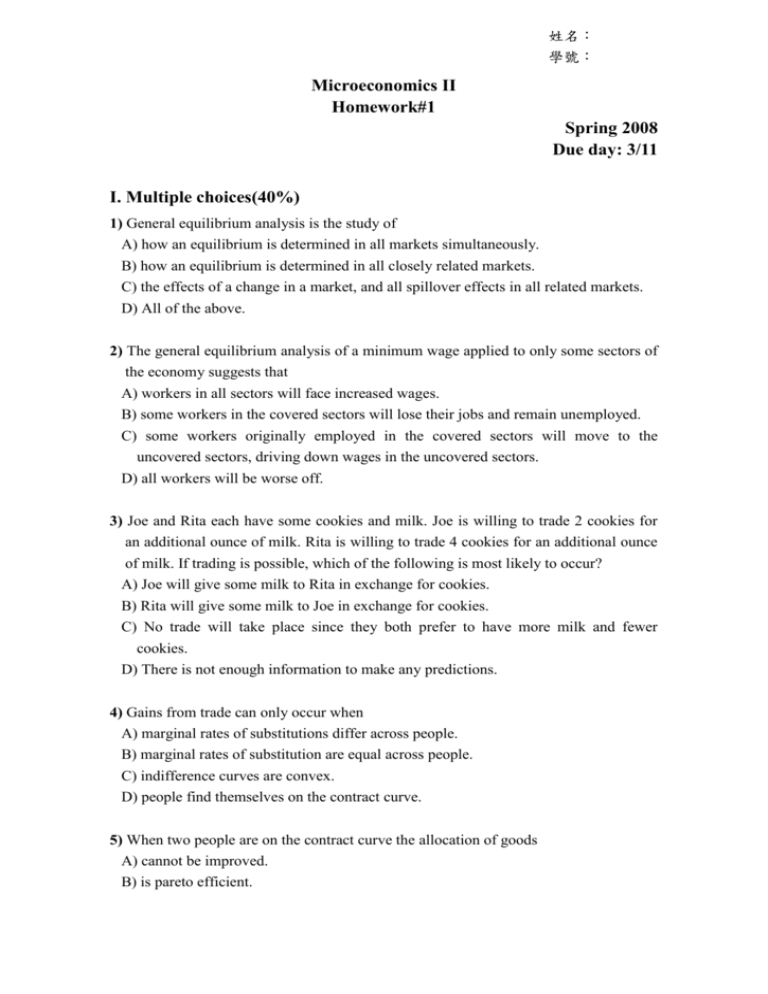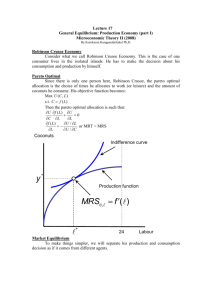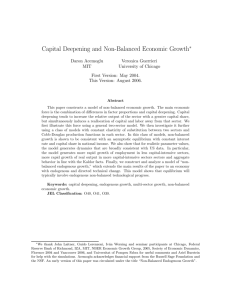Most microeconomic models assume that decision makers wish to
advertisement

姓名: 學號: Microeconomics II Homework#1 Spring 2008 Due day: 3/11 I. Multiple choices(40%) 1) General equilibrium analysis is the study of A) how an equilibrium is determined in all markets simultaneously. B) how an equilibrium is determined in all closely related markets. C) the effects of a change in a market, and all spillover effects in all related markets. D) All of the above. 2) The general equilibrium analysis of a minimum wage applied to only some sectors of the economy suggests that A) workers in all sectors will face increased wages. B) some workers in the covered sectors will lose their jobs and remain unemployed. C) some workers originally employed in the covered sectors will move to the uncovered sectors, driving down wages in the uncovered sectors. D) all workers will be worse off. 3) Joe and Rita each have some cookies and milk. Joe is willing to trade 2 cookies for an additional ounce of milk. Rita is willing to trade 4 cookies for an additional ounce of milk. If trading is possible, which of the following is most likely to occur? A) Joe will give some milk to Rita in exchange for cookies. B) Rita will give some milk to Joe in exchange for cookies. C) No trade will take place since they both prefer to have more milk and fewer cookies. D) There is not enough information to make any predictions. 4) Gains from trade can only occur when A) marginal rates of substitutions differ across people. B) marginal rates of substitution are equal across people. C) indifference curves are convex. D) people find themselves on the contract curve. 5) When two people are on the contract curve the allocation of goods A) cannot be improved. B) is pareto efficient. C) is such that neither individual can be made better off without making the other worse off. D) All of the above. 6) The above figure depicts the Edgeworth box for two individuals, Al and Bruce. The contract curve can be found by connecting points A) a and b. B) a and c. C) b and d. D) c and d. 7) The above figure depicts the Edgeworth box for two individuals, Al and Bruce. Point a is not Pareto efficient because A) Al's MRS exceeds Bruce's MRS. B) the point is not near the center of the box. C) Al's indifference curve is not far enough away from the origin. D) All of the above. 8) A competitive equilibrium is Pareto efficient because at the competitive equilibrium A) prices reflect the differences in marginal rates of substitution across individuals. B) there are no further gains from trade. C) there is an equal distribution of the goods. D) everyone has the same level of utility. 9) By saying that MRS = MRT, an economist means that A) for all goods, the value that society places on the last unit produced equals the cost of making that unit. B) for all goods, the value that a consumer places on the last unit consumed equals the value that all consumers would place on that unit. C) society is able to produce more output of one good without reducing the output of any other good. D) no other output mix is technically feasible. 10) Suppose the production possibilities for two countries, producing either food or clothing, are shown in the above figure. They can each produce any linear combination as well. Measuring food on the horizontal axis, the joint production possibility frontier A) will have a slope of -3/4 over the entire frontier. B) will have a slope of -2 when less than 20 units of food are produced. C) will have a slope of -1 when less than 20 units of food are produced. D) will have a slope of -1/2 when less than 20 units of food are produced. 1 2 3 4 5 6 7 8 9 10 D C A A D D A B A D II. Problems(60%) 1) Robinson starts out with 10 lobsters and 5 coconuts. Friday starts out with 10 lobsters and 15 coconuts. After trading, Robinson ends up with 8 lobsters and 10 coconuts. Robinson feels neither better nor worse off than when he started but cannot get Friday to agree to any more trades. Friday feels better off than when he started. Draw the Edgeworth box consistent with this story. Answer: See the above figure. 2) Consider a society consisting of just a farmer and a tailor. The farmer has 10 units of food but no clothing. The tailor has 20 units of clothing but no food. Suppose each has the utility function U = F * C. The price of clothing is always $1. If the price of food is $3, does a competitive equilibrium exist? If not, what will happen to the price of food? Answer: The farmer will have $30. His budget line is 30 = 3F + C. His budget line is tangent to an indifference curve when C/F = 3. Substituting yields 30 = 6F or F = 5 and C = 15. The tailor's budget line is 20 = 3F + C. His budget line is tangent to an indifference curve when C/F = 3. Substituting yields 20 = 6F or F = 3.33 and C = 10. In total 8.33 units of food and 25 units of clothing are demanded. There is excess demand for clothing and excess supply of food. The price of food will fall. When the price of food is $2, both markets clear.









